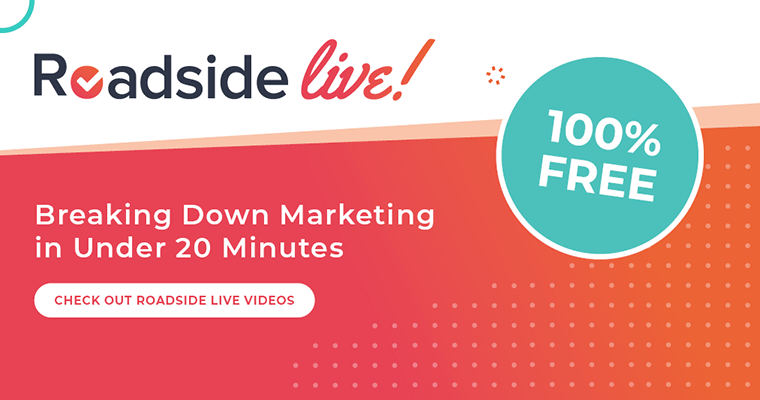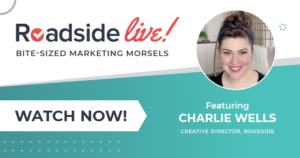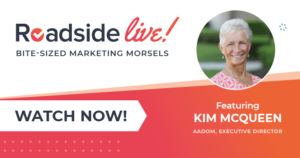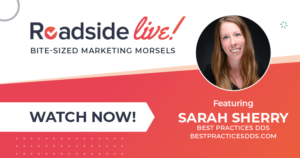Roadside Live: How NexHealth Is Changing the Dental Industry
How did NexHealth… This text opens a new tab to the NexHealth website… grow to 25,000+ healthcare providers in three years?!
Watch the video above or check out the transcript below as Kelsey interviews NexHealth’s CEO Alamin Uddin.
NexHealth (NH) is the complete patient experience solution for small, medium, and large dental practices. It offers EHR-integrated real-time online scheduling, patient communications, digital paperwork, and more.
In this Roadside Live, you’ll learn:
- How Alamin came up with NH
- How NH is changing the dental industry
- Where he sees dentistry in the next year+
- And more!
Kelsey: Hey everyone. My name is Kelsey, and I am super excited to be here today with Al, the CEO of NexHealth… This text opens a new tab to the NexHealth website….
Now likely, you’ve probably heard of this company. It’s taking the medical industry by storm. In fact, Al was actually selected in 2018 to appear in the edition of Forbes 30 under 30. And in that short period of time, he has managed to grow next health to 25,000 plus different health care providers.
So I am super excited to be able to pick your brain a little bit, to see what’s happening and what the plans are for the future. But before we do that, let’s just dive right in.
First of all, tell us who you are? How did you come up with NexHealth?
Alamin: Yeah, thank you for hosting me, Kelsey. I’m really excited to be here.
The founding story behind NexHealth is interesting in the sense that I was actually supposed to go to medical school.
I was an undergrad in college and doing the normal things you need to do to get into medical school. And one of those things that you do have to do is show that you have some exposure to the field of medicine. Most students do free volunteering or free shadowing or whatever it is to just get some experience of what it’s like being a dentist or a doctor or whatever it is you’re looking to be.
But what I did instead was I got a job at a doctor’s office as a receptionist in undergrad my last two years of college. I was in the Bronx, essentially making phone calls, taking all the phone calls, calling patients, calling insurance carriers, labs, insurance, etc. And while I’m working there as a receptionist, I was always like into technology, self-taught developer, etc.
I realized that the patient experience – specifically for me handling all the patients and all the communication, scheduling, paperwork, all of it, plus from the patient’s point of view – was super outdated.
At that time – this is 2015, 2016 – we already had Uber, Lift, DoorDash, Netflix. And all these other conveniences that we have throughout our life just did not exist within a dental office or within a healthcare practice.
Anyway, so that’s sort of the inspiration – the difference between lives that we live as consumers in every other part of our life vs. what exists today in the dental practice and the health care world was so jarring. They’re so different.
I decided we should make this easy for everyone.
Initially, I tried to sort of build this for myself for my own practice. I didn’t think we were going to start a company around this.
I built the initial product, spent some two years actually just sort of tinkering with it and doing the research and whatnot. Officially launched in early 2017, got a few paying customers, and then I would say 2018-19 onwards is when it started really taking off.
But anyways, the experiences, just me working, doing the normal day-to-day job at a doctor’s office in the Bronx, seeing all the behind-the-scenes work, plus obviously as a young consumer of healthcare, seeing that the jarring sort of difference between what we have outside of healthcare and what we have inside of healthcare, really made this seem like a promising solution.
And here we are, at the end of the hypothesis of bringing the modern tools to doctor’s offices and consumers is really starting to pay off today.
Today, we have over 25,000 practices, we’ve raised some $55 million from some of the best in Silicon Valley, and are seeing over a 350% annual growth.
Kelsey: That’s awesome to hear it. That’s an idea that was born from the trenches, you were there to start with, and that’s where it came from.
I know this firsthand, but tell everyone that’s listening, how is NexHealth changing the dental industry?
Alamin: Yeah, I think the dental industry has a couple of different problems that we’re really tracking.
And I know the most important part is what we like to call data interoperability.
And what that really means is that you have some 30, 40, or 50 different dental software systems out there – like Eaglesoft, Open Dental, Dentrix, OrthoTrac, or some obscure ones that you probably never even heard of, like DOX Pedo, for example, that we integrate with or WinOMS that we integrate with – so anyways, you have a lot of these systems out there that got installed in all these dental practices, in maybe like 2005, 2010, and whatnot 10 years ago at most even to this day you still have Dentrix and Eaglesoft office to competitors that dominate the market.
And they’re all great solutions.
The problem is that if you’re a tech company or if you’re a startup or if you’re a developer and you’re looking to build any sort of solutions for the space, you have to sort of go out there and try to integrate with some 20, 30, 30, 40 different systems out there. Most of them don’t have APIs. Most of them are not open systems.
So think about it, right? You’re a dental office, you just opened your practice, install Open Dental, you put all of your patient data in that system, and that’s sort of your workflow.
And now, you want to go out there, and you want to offer your patients better tools for scheduling, for patient communication, for tracking, and all the different systems.
And the problem is that today, if you go out there, you don’t really have any system out there that’s able to integrate with your Open Dental, Dentrix, Eaglesoft in real time for all the capabilities you need, right?
So that includes your patient communication, your online scheduling, your new patient paperwork, really all that end-to-end patient experience, including payments.
At scale, you just don’t have that one system that can read data from s your system of record, like from your Open Dental, Dentrix, Eaglesoft, or OrthoTrac that can read data, but also write data back in real time, meaning in under 30 seconds.
So that’s sort of a core problem we focused on, which is we built a universal integration solution, that’s able to read and write data every 30 seconds within every single dental software you can think about that.
We built that for ourselves, where we built this patient experience product on top of that in a core technical solution that’s able to read and write data between Dentrix and all these different solutions in real time.
We built it for ourselves, but now we’re also making that technology available to third-party vendors.
So think about your SmileDirectClub, think about Quip, the toothbrush company, think about true LARC and a bunch of these different products that you may already be using out there that’s actually now powered by our core technology. Technology that allows us to integrate and synchronize data with any sort of dental software is now also powering all these other vendors that you as a dental office may be using, but you just don’t know in the back end that it’s powered by NexHealth.
So I think that that’s sort of the core solution that we’re bringing.
Of course, on top of that, the end-to-end patient experience and the end-to-end solution that we’re helping doctors acquire more patients, retain their patients, streamline their patient experience.
But I think the more exciting part is the core technology that we built that powers our own solution, but now it’s enabled to power other solutions as well. And what it’s really doing is solving the core problem of this sort of lack of innovation in the space.
I think by making it easy for other developers, other tech companies to be able to integrate with all these dental’s systems out there, just overall accelerates innovation in the whole space.
Kelsey: Yeah, absolutely. I couldn’t agree more.
And like I said, I’ve seen it in action. I’ve seen how it’s changing, and it’s nice to see how as the dental industry changes rapidly, there’s also technology that’s going to be changing at the same speed and or ahead of it so that you can help with it.
Many of us throughout the last year, COVID kind of threw a curveball that was for many practices a wrecking ball, not just a curve.
So, what was the biggest surprise for you last year, and why?
Alamin: It’s a good question. I would say last year, the biggest surprise for me was how many practices thought that they could continue to do what they were doing and still have a good business in the sense that we even today actually if you talk to a DSL or dental practice and whatnot, you’ll notice that a lot of us are trying to go back to 2019 and 2018.
I think we all need to realize that all the trends we’re seeing in the world today – digitization, all the trends we see in terms of remote work, digitization of all the tools, the Instagrams, the Instacarts, the DoorDashes, the Teslas, all those different trends that are happening across every single industry – that’s all being accelerated by 10 years within a two year period, right?
I mean, COVID took us and said, hey, all these trends that are happening across the world, across the internet, across all technology, let’s squeeze it all into a two-year period. And that’s just the reality of it. And I think people haven’t fully digested how much the world has changed.
And I think in all of us, as dental practices, as technology companies in the world, trying to sort of go back and rewind the clock back to 2019, 2018. And I know that that’s kind of surprised me, which is most of us haven’t seen or are not able to fully digest that the world has changed and it’s really different today.
Consumer expectations are different. The technology we’re using is different. The vendors are different. All of it is different.
And if we’re not keeping up with the trends, we’re either going to get acquired by some private equity firm or go out of business.
And the resistance to it to this day still is what has surprised me so far.
Kelsey: Absolutely. Yeah. We need to stop crawling back into our comfort zone for sure. That’s where we’re comfortable, but growth is always made outside of that zone.
So, Al, I want you to kind of put on your crystal ball glasses. We’re going to try to predict or see the future.
Where do you see the industry going in the next 12 to 24 months? What kind of changes do you foresee?
Alamin: That’s a great question. I think there’s going to be, the dental industry specifically, two breeds of practices or ways of running a business that we’re going to see. These are trends that are already in place, but I think it’s just being accelerated.
Overall, I think that the main trend that’s driving all of this is just the consumerization of dental care or healthcare in general.
But what that really means is that as consumers, we’re used to a certain way of living today through all the technology that we have everywhere else. Right?
Young people and millennials, by the way, are in their forties, millennials that grew up with the internet, and that’s all they know. Millennials have kids today. They’re spending the most money. So this millennial user base, we just have a really different expectation of the world than our parents did it and everyone else did.
And we’re bringing those expectations to dental care and healthcare.
And that’s driving two changes.
One is you’ll have every single practice today needing to update their business models. Meaning, we can’t rely on the insurance carriers anymore to drive business to us. We can’t really rely on the old ways of sending mailers to patients or just putting up a sign on a door that says dentist on it and be able to acquire patients.
Millennials really have different expectations, where they expect:
- Modern care
- Even better bedside manner
- Really nice sleek, clean office with no wait time
- Digital tools that enable them to book appointments in real time, communicate with their doctors, pay through their phone.
Really everything is just being done online and through their phones.
That’s a really, really big shift for a lot of practices out there. So overall, there’s gonna be two trends.
I think the first trend is that most practices, especially the dentists that have been in business for the last 30 years or so, most practices I think will be resistant to that change.
And then overall, what will happen is that their revenue will keep on declining, and they’ll get bought out by some DSL or some private equity firm. So that trend, I think, is already actually accelerating, where a lot of practices are getting bought out by DSLs and private equity firms.
And then I think on the other extreme, you’ll have what I call entrepreneurs who just happens to be a dentist, right? Meaning entrepreneurs that come into the space that just happen to be dentists that act like tech founders or tech entrepreneurs, they come in to rebuild their office into a sleek, modern office, they adopted all the tools that they need to adapt to sort of their patients. They come in, and they give their patients exactly what they want.
So I think you will have those two trends.
The sort of older, slower, less modern, but owned by some private equity firm conglomerate. At that point, it’s really just a business.
And then you have this really nice office with modern views, everything being sleek and modern and whatnot.
So anyway, I think that you will have those two, which are private equity owned vs. entrepreneurs who just happen to be dentists. Hopefully that made sense.
Kelsey: I think it does make sense. And just going back to what you were saying with the millennials, convenience is another huge thing. Everyone wants to be able to do it now. They want their answer now, they want their bookings now, they want their appointments now, they want the reminders now.
So definitely seeing that kind of becoming more mainstream as well in the next couple of years for sure.
Alamin: And the funny thing is I just bought a Tesla recently, and now I can’t go back to a gas car because of just the sheer convenience.
I have my phone in my pocket, I get into the car, I hit the brake pedal, and I’m off and out, right?
Versus a normal car, you have to fiddle with your keys, you have to get in, you have to press the thing, and then you have to like the gear, all those things, right? Like I can’t do that anymore.
Even if I tried these days, it’s so jarring for my brain, and I almost got into an accident the other day because, with the Tesla, there’s so much more convenience than a gas car.
So I think that that’s sort of the way the world is headed and going from the earlier point, which is all the convenience that we have all across our lives today to a dental practice to a healthcare practice that sheer sort of difference in experience is I think jarring for a lot of patients. And the providers and the doctors that didn’t live up to that expectation in the future.
Kelsey: For sure. And I mean, obviously, you’re a busy person, I mean you’re running a company, you’re scaling, you’re growing rapidly.
So how do you stay on top of things? How do you keep up to date with things within your role? How do you continue to learn?
Alamin: That is an amazing question.
I think the fundamental thing that I’ve come to learn, and I think in most of our customers that are the best, they’re smarter than you are in their specific area. And you have to be humble enough to be able to ask a lot of questions and learn as quickly as possible.
So we’re out of San Francisco, the Bay Area, and some of the smartest tech people live there, and our executive team makes up people that come from in the early days of Netflix and early days of some of the best companies in the world today. And then our investors also include some of the early backers and companies like Uber or some of the early backers in companies like DoorDash and whatnot.
I mean what I’m saying:
Surround yourself with people that you can learn a lot from, and if you don’t feel challenged intellectually by those people, then you just need to change your circle and upgrade your team or whatever it is you need to do.
Once you do surround yourself with those people, I think you have to be self-aware that they may know more than you do, and you have to ask a lot of questions. You have to push them and push yourself to stay updated. So that’s one way, I would say, which is to surround yourself with the right people.
And the second way is you always have to make some time, and you have to make some room, no matter how busy you are, to just read.
I traveled back and forth a lot between San Francisco and New York, which is about a 6-hour flight, and I would say that I spend most of that six-hour flight just reading. If you don’t read a lot and you couldn’t keep up your knowledge of the world around you, it’s going to bypass you completely, and you’ll just feel left behind.
So read a lot and surround yourself with the right people.
It sounds simple, but it’s a lot harder to do, but that’s what’s worked for me so far.
Kelsey: There we go, simple but solid advice for sure.
Got one last question for you:
Are there any updates or any news that is coming down the pipeline that you want to share about NexHealth?
Alamin: That’s a great question.
I would say, no, we have a bunch of partnerships coming up and a new product that’s coming up that we’ll be announcing in the next couple of weeks. That includes partnerships with companies like SmileDirectClub with Quip, with a few other companies out there, which will help our customers get more visibility.
Meaning if you look at the world of the internet today, millennials today, right – for example, if I’m 23 or 24 or 25, and I’m looking to get teeth aligners, right?
I know I have some problems and I need to get them fixed. A company like SmileDirectClub has such a huge, huge brand that if I’m a young person and I’m looking to just get care for my teeth, the first thing I’ll typically do is go to SmileDirectClub.com and fill out their simple questionnaire and try to figure it out.
And one of the things that they’re doing now that I think is super smart is that about 50% of their patients realize that the case is either too complex or maybe they’re in a state or in some regulatory area where they can’t treat the patient online.
So what they do is they want to be able to send that patient to a real dentist; some are in the patient’s local area, and then send that patient to that dentist. And what we’re doing with SmileDirectClub is we’re making our customers available to be a part of their network so that if I’m a consumer looking at teeth aligners and I actually need to go and see a real dentist, we’re making our customers available on their site.
So now I would say some of these partnerships, I know similar partnerships include Quip and a few other companies that we’ll be announcing soon, will help our customers acquire more patients, get more visibility, and be on the sites and the platforms where modern millennials go to find care.
Kelsey: Awesome. I’m excited to see those roll out. As I’ve said in the past, I’ve been able to work from the marketing perspective on that end of it and see how NexHealth is able to help practices. Then we also work directly with the practice itself. So I can see it from both sides of that solution. It not only increases these conversions but also makes it a lot easier to track that conversion.
Al, I’d like to thank you so much much for joining us today. It has been a privilege to pick your brain, kind of seeing what’s happening, what’s coming down the pipeline.
I know we’re going to drop a link into the chat here where anyone can get the free trial if they want to give NexHealth a try or would like just to ask some questions. Maybe they wanted to see how it works. We’re going to put that in. So feel free to use that link and get in touch with Al and his team.
Alamin: Yeah. Awesome. Thank you so much for having me, Kelsey.
Book Your Free NexHealth Demo Today
Meet the guest
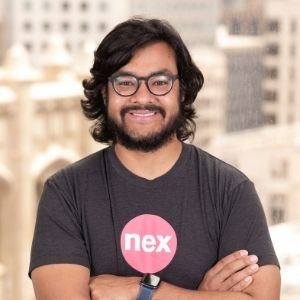 Alamin Uddin is the CEO of NexHealth… This text opens a new tab to the NexHealth website…, the complete patient experience solution for small, medium, and large dental practices. Alamin was selected to appear in the 2018 edition of Forbes 30 Under 30 and has managed a team to grow NexHealth to 25,000+ healthcare providers in three years.
Alamin Uddin is the CEO of NexHealth… This text opens a new tab to the NexHealth website…, the complete patient experience solution for small, medium, and large dental practices. Alamin was selected to appear in the 2018 edition of Forbes 30 Under 30 and has managed a team to grow NexHealth to 25,000+ healthcare providers in three years.

